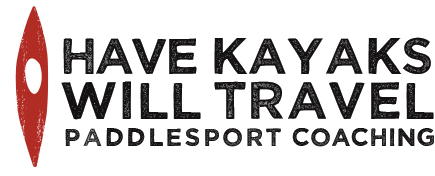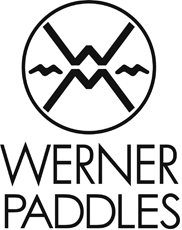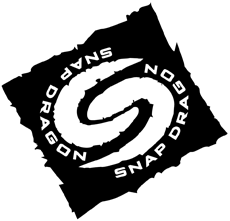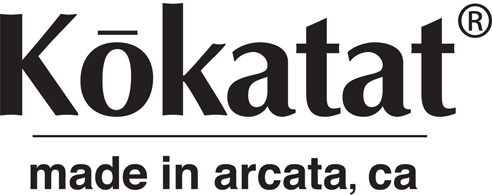Mention Canoecopia to midwest paddlers and they fairly glow with pride. The world’s largest paddlesport expo happens here–in Madison, Wisconsin, to be precise–every March. Take that, coastal paddlers! Kelly Blades, P&H Midwest Guy, shows Sharon the new Delphin 150. Canoecopia is a hybrid trade show and symposium. The expo hall is filled with vendors of boats, paddles, spray decks, clothing, safety gear, tents and other paddling and camping necessities, along with outfitters, schools, publications and more. Meanwhile, there are ten presentations every hour for two and a half days on a wide variety of topics, and the entrance hallway is lined with clubs, nonprofit groups and other organizations. Shawna Franklin and Leon Somme of Body Boat Blade present “Tow Systems,” dispelling many misconceptions about this essential piece of safety gear. Many people come for the access to an astonishing variety of gear and the 15 percent discount. But to view Canoecopia as a chance to get deals is to miss the point. Rather, we’re drawn to Canoeopia every year because it’s an opportunity to see and touch all that’s new, to hear the latest ideas and learn about the adventures and innovations of the movers and shakers in paddlesport, and to connect or reconnect with friends and contacts throughout the industry. Nigel Dennis talks to a customer about his SKUK boats. Here, under one roof, you can have a detailed discussion with Nigel Dennis, owner of SKUK and designer of its boats; Peter Orton, who designs the Valley line; and Graham Mackereth owner of P&H. You can talk with the top salespeople for paddling gear manufacturers, like Danny Mongno of Werner Paddles, Brian Cooke of Level Six and Jeff Turner of Kokatat. You can get maps and guidance from Parks Canada, sign up for a course with Wilderness Medical Associates, and talk to the publisher of the Rapid Media magazines. As Morgan Goldie, sales manager of Northwater, mentioned in an off-hand comment, “If the roof caved in right now, we’d lose the brain trust of paddlesport. It would be devastating for North America.” A wristband-wearing customer tries on a new helmet. Fortunately, the roof didn’t cave in. It was the biggest show yet, measured in traffic and sales, but by midnight on Sunday, Canoecopia had packed up and left. And true to the outdoor ethic of leave-no-trace, the Alliant Energy Center shows no evidence that Canoecopia was ever...
Dry land river reading activity
Smurf avoids the hydraulic with the log stuck in it. Our 10-week spring kayaking class at the local YMCA is almost over. We’ve spent time teaching rolling and basic strokes in a small pool augmented only by slalom gates and our own imaginations. Some of our activities are of our own creation, but one we owe entirely to Tom Lindblade, president of the Illinois Paddling Council, instructor trainer for countless canoe instructors, instructor to countless canoe students, advocate for local waterways and paddlers…in short, a mentor to us all. It’s the “river in a box.” Simply put, it’s a long piece of denim on a gradient with some pieces of yarn and a bunch of rocks, sticks and other river accessories. Ours also features pillow stuffing to simulate whitewater, and a Smurf paddler with an awesome helmet you can’t buy in any larger size. After showing a short film clip about river reading and talking about river features, how they’re created and how they affect paddlers, we had our students create the river banks and eddy lines with the yarn and place the rocks, twigs and stuffing on the river. Then we looked at what our Smurf would experience as he headed down the river, choosing safe routes and play...
Why we love the draw stroke
Poor devils.
Coaches: Course reporting just got easy. Really!
Every four years, ACA-certified instructors need to provide evidence that we’ve taught at least two courses (including one at our level of certification) and participated in one instructor update. Doing those things has never been an issue, but reporting them has felt like a hassle. Until now. The American Canoe Association just instituted Smartphone Course Reporting. All we have to do is go to the ACA site, americancanoe.org … … and click on the “EZ Skills Course Report Form” … … and the form pops up! Yes, we still have to remember our nine-digit ACA numbers (how we miss the five-digit ones!), but other than that, it could not be easier to register courses and keep our certifications. There are other reasons to register courses, too. Like any advocacy organization, the ACA derives strength from numbers. It keeps track of how many students undergo training and therefore become safer paddlers; this information is useful when it seeks funding for everything from education to stewardship. So no more excuses. And no more cringing when you get the email warning that your certification is in jeopardy. It just doesn’t get EZier than...
Placing a value on kayak instruction
CASKA night at the UIC pool. Earlier this week, we organized an evening of instruction for CASKA, the Chicago Area Sea Kayakers Association. We are board members of this club, which has a mission that includes promoting safe paddling. An excellent recent article by Howard Meyerson in the Grand Rapids Press demonstrated the need for more general awareness of the connection between instruction and paddling safety. Meyerson reported about a novice paddler who purchased a 12-foot boat and set out from Glen Haven to South Manitou Island, unprepared in every way for the challenge of an open crossing in cold weather. His adventure ended in a Coast Guard helicopter rescue. Stories like this vex sea kayak coaches because they are so familiar. We’ve all met plenty of people who don’t see the need for instruction–people who have too much confidence in themselves and too little respect for the value of training. They get themselves in trouble and also endanger the people who have to rescue them. And they give paddlers a bad reputation. By contrast, the 14 people who came to the pool for instruction earlier this week demonstrated a respect for the sport, an awareness of the risks, and a willingness to pay money to improve their skill and knowledge. It was a great fundraiser for the club, but also a morale booster for all of us who have spent time and money to become skilled paddlers and coaches, and who are committed to helping others paddle...
Signs of Spring for kayakers
We just picked up 26 new Werner paddles from Geneva Kayak Center for the Chicago Whitewater Association’s pool classes. We can’t wait to get them in our students’ hands! Everything’s coming up...
An SKUK Expedition Center in Illinois?
When we think about Sea Kayaking UK Expedition Centers, we think about Wales, Scotland and Cornwall — places situated in the UK and on the sea. Turns out there are 16 Expedition Centers in North America, too, but they’re primarily situated (not surprisingly) on the coasts: Maine, North Carolina, San Francisco, Washington. Except for two: Living Adventure on Lake Superior in Wisconsin, and Geneva Kayak Center* in Yorkville, IL. Geneva Kayak Center in Yorkville, IL Yorkville? We had to ask co-owner Ryan Rushton how this came about. Ryan Ruchton at Geneva Kayak Center. Q: How did you earn this designation?A: Each Expedition Center has to be staffed by at least one BCU 5-star Sea Leader award holder. We actually have two on staff; Scott Fairty and I are the only 5-star paddlers in the region to the best of my knowledge. Being assessed as a BCU 5-star paddler requires years of sea kayaking in different environments, ability to handle your boat unconsciously in advanced conditions and possessing high levels of leadership and seamanship. Q: What about location? A: The other prerequisite for becoming an Expedition Center is that your center is located in abeautiful, amazing place to paddle. Nigel [Dennis] wanted to give paddlers from around the world the option to use his boats and Lendal paddles in places like Alaska, Greece, Newfoundland, Maine, Iceland, Norway, Georgia and Baja. Beyond using his boats, he wanted to make sure they would have the top leadership for courses and expeditions when paddlers traveled to these locations. Chicago is a great place to paddle and an excellent training ground for sea kayaking. Q: You aren’t exactly on the coast. So how does that work? A: While Chicago is a great place to paddle, we do not have the venue that other SKUK Expedition Centers have. The major hurdle was simply putting an expedition center in Chicago. Our top level programs on the local and regional level, combined with our regional, national and international adventure paddling programs put us over the top. Geneva Kayak Center offers paddling trips far beyond Chicago. Q: What will this mean for Chicago area paddlers? I hope that this will be an additional factor in bringing more national and international exposure to paddling in the Chicago area as well as the Great Lakes. Chicago’s Lakefront is a seriously good sea kayak training ground. The variety of landforms and fetch in multiple directions gives paddlers the conditions needed to improve as sea kayakers. Combined with focused training on high volume whitewater rivers, Midwest paddlers can come to GKC for training that will prepare them to paddle anywhere in the world. Q: What will it mean for Geneva Kayak?A: Designation as an Expedition Center is a big step for Geneva Kayak. In 2011 we were designated as an ACA [American Canoe Association] Pro School, which gave GKC national recognition for our kayak school....
What we carry in our PFDs
Our last post about PFDs resulted in a number of queries via Facebook and email: “So what do you carry in your PFDs? What’s inside each of our pockets: Sharon (left) and Alec (right). As we mentioned, this is a topic we recently researched through interviews with a number of notable sea kayak coaches and expeditioners. We had begun paring down on our kit, and we wondered what other paddlers were doing. You can read about what they told us in the Summer/Fall 2011 issue of Adventure Kayak Magazine. What we carry depends considerably on where we are going and what we are doing. But here’s what we nearly always carry in and on our PFDs. (We might add items in certain situations.) VHF radio waterproof camera whistle compass white light strobe knife snack sunscreen lip balm grease pencil very small first aid kit very small boat repair kit watch And some personal things:Alec: back-up reading glasses, hair ties.Sharon: nose clips. View number two, with everything spread out. Some people carry a hydration pack, which is a convenience but adds considerable weight and bulk. That can put strain on your back and shoulders. We were curious what our kit weighed, so we put it on a scale. Alec’s kit weighs two pounds (32 oz.), without the plate. Our philosophy for whether something belongs in/on our PFDs or in a day hatch is this: If we are likely to need it while we’re on the water, and if it isn’t a burden, it’s in our PFDs. But if we can reasonably expect to stop and get something from a day hatch, it can stay there. Carrying more kit does make a PFD heavier and bulkier, which is hard on your body, diminishes flexibility, weighs you down and makes it harder to self-rescue. Those are safety considerations. But needing something you can’t access is also problematic. Like everything else, there aren’t any cut-and-dried answers. It’s a judgment call. But it’s a good idea to reconsider what you’re carrying each time you go out and adjust it for the expected situation. So what do you carry in and on your...
Product review: Kokatat MsFit Tour and Ronin Pro PFDs
Eventually, even the best gear wears out. After six years of heavy use and exposure to the elements, the fabric on Alec’s Kokatat MsFit Tour PFD was deteriorating, the retroreflective tape wasn’t retroreflecting, and the zipper tabs were gone from the pockets. Sadly, it was time to replace it. Nothing lasts forever, not even a well-made PFD. We think pretty differently about some aspects of sea kayaking than we did six years ago, so this was an opportunity to consider whether a different PFD might be better. We no longer try to stash in them everything we could possibly need if we were separated from our boats and far from shore. In fact, we try to carry as little as possible for the conditions in which we’re paddling. No more flares, signal mirrors, hefty first aid kits, and excessive food and water. Like many of the coaches and expeditioners we interviewed for a Summer/Fall 2011 article in Adventure Kayak Magazine, we now consider it a hazard to be overburdened with gear, so we try to carry only the essentials and ensure that many items serve multiple purposes. If we need more than that, we’ve really screwed up. But some things haven’t changed. Kokatat still offers terrific gear that’s made in the US and backed by excellent customer service. And the MsFit Tour is still the gold standard among PFDs–another observation we made while researching our article, “The Right Stuff.” So we decided to try out the Ronin Pro, an attractive vest with only one big pocket because it is designed for whitewater paddlers, and the new MsFit Tour. The new Ronin Pro (left) and MsFit Tour (right). Alec was the only one of us in the market for a new PFD, so we got a small/medium Ronin Pro (the smallest size for that model) and a medium MsFit Tour. Both fit Alec, who is 5’4″ and 140 pounds; neither was small enough for Sharon, who is 5’1″ and 110 pounds and was therefore relegated to documenting the product testing. The new MsFit Tour features a clever pouch above the lash tab so a knife can be tucked in. The new MsFit Tour boasts some improvements over the old one. The Gaia PVC-free foam feels comfy and broken in when it’s brand new, and the zipper tabs are larger and sturdier. The two side pockets are slightly larger and have an extra zippered pouch on them. The lash tab has been moved up and the fabric pouch on the shoulder extended down to provide an ingenious spot to tuck a knife. No more intimidating students or losing $60 knives! The Ronin Pro features exceptionally large cut-outs around the arms. The Ronin Pro...
The poetry of Lake Michigan in winter
These fragments I have shored against my ruins. –T.S.Eliot, The Waste Land The lake looks like a mosaic now. A mosaic is a conversation that takes place on surfaces. A mosaic is a conversation with light, with color, with form. A mosaic is a conversation with time. —Terry Tempest Williams, Finding Beauty in a Broken...







